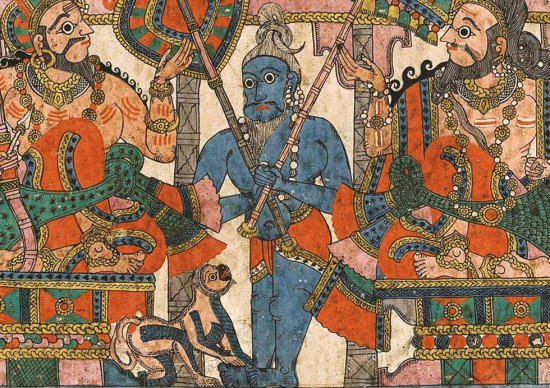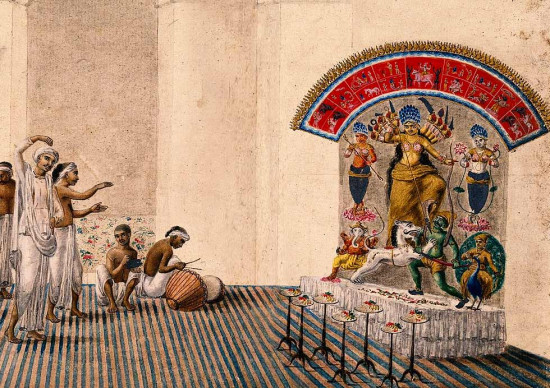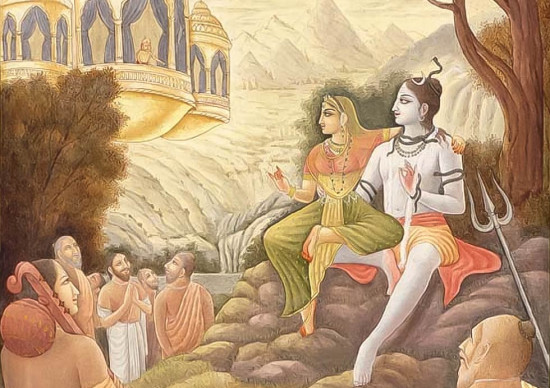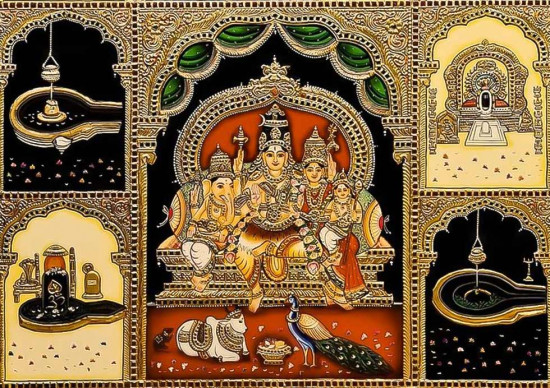Among Lord Shiva’s captivating and diverse forms, Somaskanda Murti stands out for its portrayal of divine family and harmony. While Shiva exhibits numerous awe-inspiring forms like Ardhanarishwara and Dakshinamurti, Somaskanda Murti presents a tender image of him with his consort Parvati and their son Skanda, embodying love, parenthood, and the sacred union of the divine.
Somaskanda, a manifestation of Lord Shiva, portrays him in a seated posture with his consort Parvati and their son Skanda. This revered depiction has been cherished in the Tamil region for centuries, with the earliest stone panels dating back to the 7th century CE. Shiva temples in Tondai Naadu, particularly around Kanchipuram, often feature a Somaskanda panel behind the Shivalingam. The Chola period (9th century onwards) marked the emergence of rich bronze images representing Somaskanda. In this unique concept, Shiva is depicted as the Supreme Godhead, Parvati as a gracious mother, and Skanda as their beloved son. Notably, Kanchipuram’s Ekambreswarar temple lacks a shrine to Shakti, but the Kamakshi Amman temple and the Kumara Kottam temple, dedicated to Skanda, form a Somaskanda arrangement. Similar formations exist in other temples, emphasizing the significance of Somaskanda in the region, especially at Tiruvarur and the Sapta Vitanka shrines.
Somaskanda, a manifestation of Lord Shiva, portrays him in a seated posture with his consort Parvati and their son Skanda. This revered depiction has been cherished in the Tamil region for centuries, with the earliest stone panels dating back to the 7th century CE. Shiva temples in Tondai Naadu, particularly around Kanchipuram, often feature a Somaskanda panel behind the Shivalingam. The Chola period (9th century onwards) marked the emergence of rich bronze images representing Somaskanda. In this unique concept, Shiva is depicted as the Supreme Godhead, Parvati as a gracious mother, and Skanda as their beloved son. Notably, Kanchipuram’s Ekambreswarar temple lacks a shrine to Shakti, but the Kamakshi Amman temple and the Kumara Kottam temple, dedicated to Skanda, form a Somaskanda arrangement. Similar formations exist in other temples, emphasizing the significance of Somaskanda in the region, especially at Tiruvarur and the Sapta Vitanka shrines.
Iconography of Somaskanda Murti
In the Somaskanda Murti (सोमास्कन्द), Lord Shiva is depicted seated with Uma and Kartikeya, also known as Skanda. Shiva is in a sukhasana, with his left leg folded upwards and the other resting downward. He has four arms, with the back two holding Yagya in the form of a deer, representing the incident when Shiva destroyed Daksha’s Yagya. The right back hand holds a Parashu. In his lower right hand, he engages in the pataka-hasta, while his lower left hand gracefully performs the kapittha.
Lord Shiva wears a Jatamukuta, where his hair is tied into a bun covered with ornaments resembling a crown. Kundalas (earrings) adorn both ears, with a female kundala in the left ear and a male kundala in the right, symbolizing both feminine and masculine energy. These kundalas are known as Makara kundalas, shaped like crocodiles. His face is portrayed with a serene and tranquil expression, featuring a third eye on her forehead.
Around Shiva’s neck, two neck chains are depicted. A yajnopavita crosses his torso from the left shoulder to the right arm backward. He wears an Udarbandha and Keyura (bracelet) on his arms, with keyura worn above the elbow. Valyas, another type of bracelet, adorns his lower arms at the wrists.
Lord Shiva wears a Jatamukuta, where his hair is tied into a bun covered with ornaments resembling a crown. Kundalas (earrings) adorn both ears, with a female kundala in the left ear and a male kundala in the right, symbolizing both feminine and masculine energy. These kundalas are known as Makara kundalas, shaped like crocodiles. His face is portrayed with a serene and tranquil expression, featuring a third eye on her forehead.
Around Shiva’s neck, two neck chains are depicted. A yajnopavita crosses his torso from the left shoulder to the right arm backward. He wears an Udarbandha and Keyura (bracelet) on his arms, with keyura worn above the elbow. Valyas, another type of bracelet, adorns his lower arms at the wrists.
He is depicted wearing a Mekhala (waistband) around his waist, along with a lower garment secured at the waist. Additionally, a band is visible on his thighs, while his feet are adorned with anklets on the right leg, complemented by a band around the shin.
Turning our attention to Devi Uma, she is depicted with an aura of serenity, radiating peace and tranquility. Seated gracefully to the left of Lord Shiva, she assumes a sukhasana posture with her right leg folded upwards and her left leg extended. Adorning a Karanda mukuta, her countenance reflects a peaceful expression.
On her ears she wears makara -kundalas (a type of earring). A beautiful necklace is adorning on her neck, and a Yajnapavita flows from above her left shoulder and below her right arm. With two hands gracefully performing the kapittha-hasta. Her breasts are depicted very firm as she is the mother of the universe. Her hands are adorned with keyura (anklet) or kankana (bangles). In this depiction, the right hand assumes the Kataka Mudra, symbolizing fascination and enchantment, while the left hand is in the Varada Mudra, signifying a gesture of granting boons.
Devi Parvati is adorned with exquisite ornaments, including haras (religious bracelets) and other gem-encrusted pieces, accentuating her divine status. She is portrayed donning fine attire that drapes gracefully around her legs, which are as smooth and stout as the trunk of a banana plant. She wears anklets on her feet.
Devi Uma shares the divine space with their son, Skanda, who stands in the araimandi pose or vitastik-sthanaka with slightly bent knees. Skanda’s hands are engaged in the kartarimukha mudra, holding a lotus flower in his right hand. This intricate portrayal captures the familial harmony and divine grace of this sacred trio. This intricate depiction reflects the divine energy of the cosmic family in Hindu mythology.
Turning our attention to Devi Uma, she is depicted with an aura of serenity, radiating peace and tranquility. Seated gracefully to the left of Lord Shiva, she assumes a sukhasana posture with her right leg folded upwards and her left leg extended. Adorning a Karanda mukuta, her countenance reflects a peaceful expression.
On her ears she wears makara -kundalas (a type of earring). A beautiful necklace is adorning on her neck, and a Yajnapavita flows from above her left shoulder and below her right arm. With two hands gracefully performing the kapittha-hasta. Her breasts are depicted very firm as she is the mother of the universe. Her hands are adorned with keyura (anklet) or kankana (bangles). In this depiction, the right hand assumes the Kataka Mudra, symbolizing fascination and enchantment, while the left hand is in the Varada Mudra, signifying a gesture of granting boons.
Devi Parvati is adorned with exquisite ornaments, including haras (religious bracelets) and other gem-encrusted pieces, accentuating her divine status. She is portrayed donning fine attire that drapes gracefully around her legs, which are as smooth and stout as the trunk of a banana plant. She wears anklets on her feet.
Devi Uma shares the divine space with their son, Skanda, who stands in the araimandi pose or vitastik-sthanaka with slightly bent knees. Skanda’s hands are engaged in the kartarimukha mudra, holding a lotus flower in his right hand. This intricate portrayal captures the familial harmony and divine grace of this sacred trio. This intricate depiction reflects the divine energy of the cosmic family in Hindu mythology.
The legend of Somaskanda Murti

According to the legend, Vishnu wanted a child and worshiped Shiva at Tiruvarur. Shiva granted his wish, and Vishnu had a son named Kaama. However, Parvati (Shakti) got upset because Vishnu didn’t involve her in the worship, and she cursed that Shiva would burn their child to death (refer to the Kumarasambhava legend).
When Vishnu realized the curse, he created a combined image of Shiva, Uma, and Skanda called Somaskanda, symbolizing fertility, and worshiped it. Parvati lifted the curse, explaining that despite being burned, Kaama would survive to create attraction between males and females, ensuring the human race’s continuity.
Somaskanda typically shows Shiva in a seated position with Parvati to his left and Skanda, their son, between them. In most Saivite temples, Somaskanda is the processional image of Shiva, and there’s usually a shrine for the Utsavamurthy Somaskanda. Tyagaraja, a unique representation of Somaskanda, is found in only a few temples, such as Tiruvarur.
When Vishnu realized the curse, he created a combined image of Shiva, Uma, and Skanda called Somaskanda, symbolizing fertility, and worshiped it. Parvati lifted the curse, explaining that despite being burned, Kaama would survive to create attraction between males and females, ensuring the human race’s continuity.
Somaskanda typically shows Shiva in a seated position with Parvati to his left and Skanda, their son, between them. In most Saivite temples, Somaskanda is the processional image of Shiva, and there’s usually a shrine for the Utsavamurthy Somaskanda. Tyagaraja, a unique representation of Somaskanda, is found in only a few temples, such as Tiruvarur.









